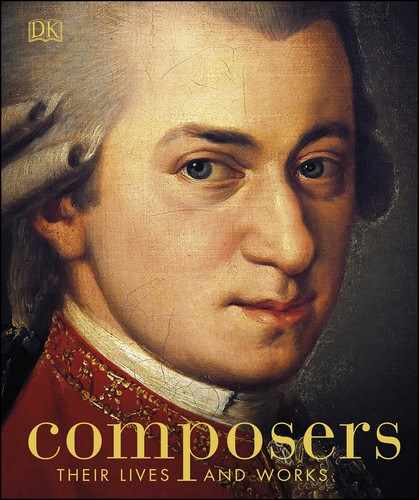Henry Purcell
1659–1695, ENGLISH
Famed, above all, for Dido and Aeneas—the first true English opera—Purcell was one of the greatest and most versatile composers of the Baroque period.

HENRY PURCELL, c. 1695
This portrait of Henry Purcell was painted by John Closterman in the year of the great composer’s tragically early death in 1695. He was just 36 and at the peak of his career. The illness that caused his death is unknown, although there is speculation that it was tuberculosis. There is also speculation that he died from a chill, which he caught when he came home drunk one night and his wife locked him out of the house.
IN CONTEXT
Purcell and Queen Mary
In 1689, the accession of William III and Mary II to the throne marked a crucial point in Purcell’s career. While the king was something of a philistine, Queen Mary loved music and was an enthusiastic patron of the arts. For her, Purcell wrote his finest birthday odes, including the colorful “Come, ye sons of art.” In March 1695, he also provided the music for Mary’s funeral in Westminster Abbey. One of the pieces sung at the burial service, “Thou knowest, Lord, the secrets of our hearts,” was performed at Purcell’s own funeral later that year.

SILVER MEDAL FOR THE CORONATION OF WILLIAM AND MARY, 1689
During his brief yet hectic lifetime, Henry Purcell was acknowledged as unequaled among English composers. After his premature death at the age of 36, he was hailed by contemporary commentators as “our all-pleasing Britain’s Orpheus” and “the Delight of the Nation and the Wonder of the World.” A century later, he had become “our musical Shakespeare.” None of the composers of his day matched his melodic genius or his inspired eclecticism, which absorbed the fashionable continental styles of Lully and Corelli without sacrificing a quintessential Englishness. His great sensitivity to the rhythms of the English language remains unsurpassed.
Yet the biography of the composer who became a national icon remains fragmentary. What is certain is that he was born into a family of court musicians in 1659, grew up in the shadow of Westminster Abbey, London, and was one of 12 boy trebles in the Chapel Royal. At the age of 18, he was appointed “composer-in-ordinary for the king’s violins.” In 1679, he became organist of Westminster Abbey, and a year or two later he married Frances Peters.

DIDO AND AENEAS, SET DESIGN
Illustration of the set for Purcell’s opera Dido and Aeneas, designed by Francesco da Bibiena in 1712. Bibiena, an architect, not only built theaters, but was famous for his spectacular set designs.
Building a career
For the next decade, Purcell’s career centered on court and chapel, with the production of verse anthems, royal odes, royal welcome songs (in which the music repeatedly transcends the sycophantic texts), and, in 1685, coronation anthems for James II. His sets of viol fantasias and the Italianate sonatas in three and four parts reveal his genius, not least in their rich chromatic harmonies. The poignantly concise Dido and Aeneas (c. 1683–1689) tells the story of the love between Aeneas, hero of Virgil’s epic poem the Aeneid, and the Carthaginian queen Dido, who commits suicide when Aeneas is tricked into abandoning her.
After James II was overthrown in 1688, Purcell’s creative activities broadened. From 1689, he provided birthday odes for Queen Mary II (see box). But with the militaristic William III opposed to elaborate church music, he now began to write for a broader middle-class audience: in the published sets of “choyce ayres and songs,” in incidental music for plays, and in the “semi-operas” (as the contemporary writer Roger North dubbed them) for the Dorset Garden Theatre, off Fleet Street. Purcell the court composer had morphed into a composer for the commercial stage.
All-sung opera, that dangerously exotic Italian import, was still deemed alien to the “robust” English temperament. The recipe for public success was to take an existing play, fillet it, and stuff it with music, dance, and spectacular scenic effects. These multi-media extravaganzas, involving separate casts of actors, dancers, and singers, present a serious challenge to today’s producers and are therefore rarely performed. Yet the four semi-operas—Dioclesian, King Arthur, The Fairy-Queen, and The Indian Queen—from Purcell’s final years contain some of his most atmospheric and melodically alluring music.

SCORE FROM THE FAIRY-QUEEN
This handwritten score is of the aria “Thrice Happy Lovers” from Act 5 of Purcell’s semi-opera The Fairy-Queen of 1692. The piece cautions against jealousy and the “anxious Care and Strife,/That attends a married Life.”
